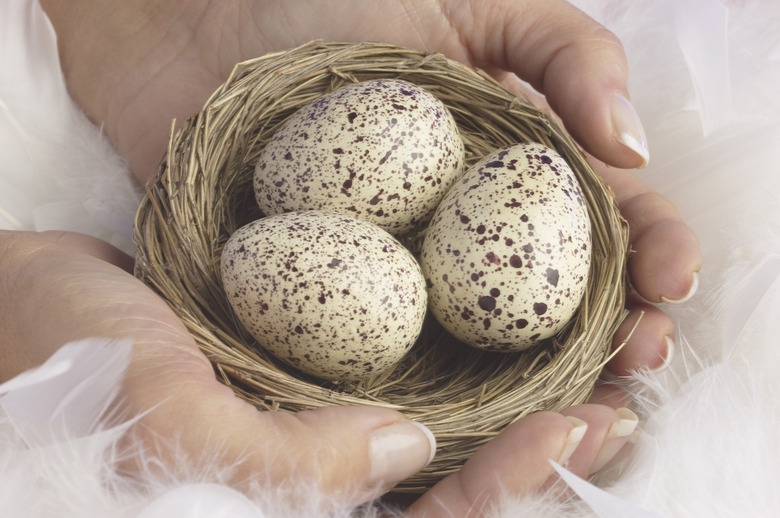What Time Of Year Do Wild Birds Lay Eggs?
The sight of birds nesting and laying eggs evokes a spring tradition. However, while many birds do breed and lay eggs in spring, several species do not follow this pattern. Some begin as early as winter, some late in summer, and yet others breed and lay year-round. Many factors affect egg laying, such as fitness, day length, food abundance and environmental temperature. If one of these variables changes, the seasonality of egg laying may shift as well.
TL;DR (Too Long; Didn't Read)
While spring brings to mind egg-laying in wild birds, many species breed and lay eggs at different times of the year. Some birds lay in spring, high summer, late winter or year-round. Factors affecting egg-laying include fitness, day length, temperature, food abundance and latitude.
Fitness and Laying Intervals
Fitness and Laying Intervals
A number of factors affect when wild birds lay their eggs. The date of laying and clutch size is related to the birds' fitness. Females that breed early in a season rely on abundant territory food and mates with stronger sexual signals. When food is scarce, laying intervals lengthen. Birds who begin breeding early in a season have higher reproductive success than those who may breed later. For those birds who choose to lay a second clutch of eggs later in the season, stressors such as molting and preparation for winter prove challenging. Late fledglings face greater risk from predation and declining food resources as well.
Day Length Effects
Day Length Effects
Photoperiod, or day length, strongly affects the window of reproduction as well. Day length plays a role in hormone levels among potential mates, and it affects what food sources are prevalent in the environment.
The Effect of Latitude
The Effect of Latitude
Latitude plays a role in breeding season as well. Wild birds that live at high latitudes, such as many sandpipers, must squeeze their breeding season into a much shorter window of time versus birds in southern latitudes. Even their young develop much more quickly due to the brief season.
Temperature Influences
Temperature Influences
Temperature directly affects egg laying in many wild birds. Warmer conditions lead to changes such as plants flowering earlier and other food becoming available sooner. Anomalous warmth has led to some birds laying eggs outside their normal seasons. Studies demonstrate that temperature affects laying dates far more than simple food abundance or day length.
Egg-Laying in Spring
Egg-Laying in Spring
Many birds in temperate regions follow the classic pattern of spring egg laying. Signature increases in birdsong can begin as early as mid-January. The advent of spring heralds longer day length and warmer temperatures, which in turn assure more abundant food sources, particularly in the form of insects. The appearance of caterpillars coincides with the egg laying of blue tits. Migratory birds return and establish territories immediately. Even non-migratory birds may establish new territories in spring. Wild birds begin making nests in trees, on the ground or even in human-made structures. Once mated, females can produce one egg per day. The iconic American robin, often considered a harbinger of spring, may make four or five nests per season.
Egg-Laying in Winter
Egg-Laying in Winter
Some wild bird species begin laying eggs in winter. The crossbill lays eggs as early as January to take advantage of an abundance of winter pine seeds. Some bald eagles begin breeding in January, extending their breeding season as late as August. Breeding pairs overwinter among mild conditions and can therefore begin breeding as soon as late winter.
Late and Year-Round Layers
Late and Year-Round Layers
Mourning doves, collared doves and pigeons represent wild birds that breed throughout the year. These bird species rely upon a year-round abundance of food in people's gardens. Mourning doves alone can have as many as six broods per year in southern latitudes. In contrast, goldfinches wait until summer or even early fall to lay their eggs. Again, food prevalence plays a role, as the chief food for goldfinches are seeds from different wildflowers. They also rely upon milkweed and thistles for nesting material.
References
- The Cornell Lab of Ornithology NestWatch: Nesting Cycle
- Birds & Blooms: Bird Nesting 101: Guide to Late Nesters
- International Wader Study Group: Egg-laying Intervals in Shorebirds
- California Department of Fish and Wildlife: Bald Eagles in California
- Philosophical Transactions of the Royal Society B: Biological Sciences: The Timing of Birds' Breeding Seasons: A Review of Experiments That Manipulated Timing of Breeding
- The Royal Society for the Protection of Birds: For Spring, Birds Start Here
- Proceedings of the Royal Society B: Biological Sciences: Temperature Has a Causal Effect on Avian Timing of Reproduction
Cite This Article
MLA
Hermance, Dianne. "What Time Of Year Do Wild Birds Lay Eggs?" sciencing.com, https://www.sciencing.com/time-wild-birds-lay-eggs-5194461/. 21 May 2018.
APA
Hermance, Dianne. (2018, May 21). What Time Of Year Do Wild Birds Lay Eggs?. sciencing.com. Retrieved from https://www.sciencing.com/time-wild-birds-lay-eggs-5194461/
Chicago
Hermance, Dianne. What Time Of Year Do Wild Birds Lay Eggs? last modified March 24, 2022. https://www.sciencing.com/time-wild-birds-lay-eggs-5194461/
